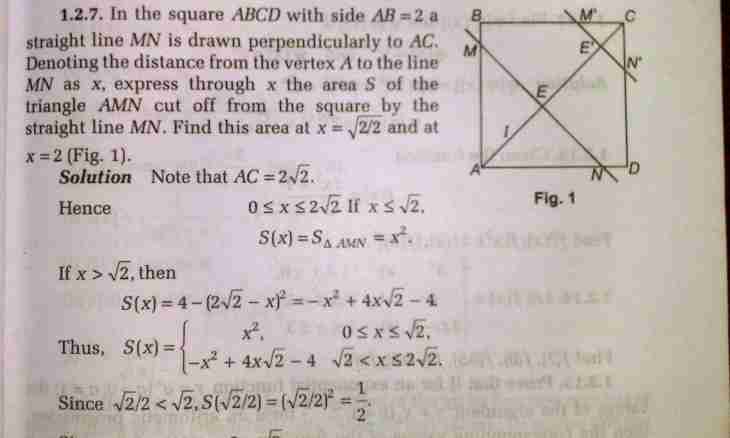If on both sides of some plane there are points belonging to a volume figure (for example, to a polyhedron), it is possible to call this plane a secant. And the two-dimensional figure formed by the general points of the plane and a polyhedron in this case is called section. Such section will be diagonal if one of diagonals of the basis belongs to a secant of the plane.
Instruction
1. Diagonal section of a cube has the form of a rectangle which it is easy to calculate (S) Square, knowing length of any edge (a) of a volume figure. In this rectangle of one of the parties there will be a height coinciding with edge length. Another - diagonals - calculate length on Pythagorean theorem for a triangle in which it is a hypotenuse, and two edges of the basis - legs. In a general view it can be written down so: a * √ 2. Find the area of diagonal section multiplication of two of its parties which lengths you found out: S = a*a * √ 2 = a² * √ 2. For example, with a length of edge of 20 cm the area of diagonal section of a cube has to be approximately equal 20² * √ 2 ≈ 565.686 cm².
2. For calculation of the area of diagonal section of a parallelepiped (S) act also, but consider that legs of different length - length (l) and width (w) of a volume figure in this case participate in Pythagorean theorem. Diagonal length in this case will be equal √ (l²+w²). Height (h) can differ from lengths of edges of the bases too therefore in a general view the formula of cross-sectional area can be written down so: S = h * √ (l²+w²). For example, if length, height and width of a parallelepiped are equal, respectively, 10, 20 and 30 cm, the area of its diagonal section will be about 30 * √ (10²+20²) = 30 * √ 500 ≈ 670.82 cm².
3. Diagonal section of a quadrangular pyramid has triangular shape. If height (H) of this polyhedron is known, and in its basis the rectangle, lengths of adjacent edges lies (an and b) whom are given in conditions too, begin calculation of cross-sectional area (S) with calculation of length of diagonal of the basis. As well as in the previous steps use for this purpose a triangle from two edges of the basis and diagonal where on Pythagorean theorem length of a hypotenuse is equal √ (a²+b²). Pyramid height in such polyhedron coincides with height of a triangle of diagonal section lowered on the party which length you just determined. Therefore for finding of the area of a triangle find a half from the work of height at diagonal length: S = ½*H * √ (a²+b²). For example, with a height of 30 cm and lengths of the adjacent parties of the basis 40 and 50 cm the area of diagonal section has to be approximately equal ½*30 * √ (40²+50²) = 15 * √ 4100 ≈ 960.47 cm².

